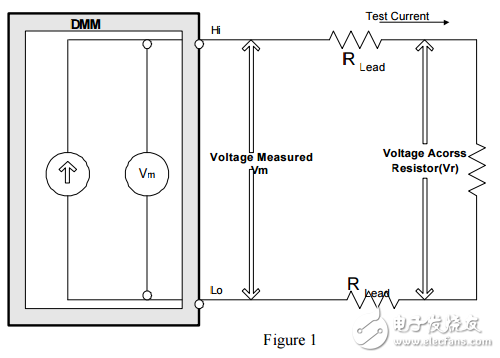
资料下载

电阻测试:四点法与两点法的原理与差异(简单)
What is the difference between 4-wire and 2-wire Ohms measurements? Figure 1 below illustrates the method used in 2-wire Ohms measurement. The test current (I) is forced through the test lead into the Device Under Test (R)。 The Voltmeter (Vm) measures the voltage developed at the HI and LO terminals. This voltage will be from the IxR drop across the Device Under Test (DUT) as well as from the IxR from the test leads. Measured Resistance = Vm = Rs + (2xRLead) I Typical Lead Resistance is in the range of 1mohm to 100mohms. This Lead Resistance will be a significant source of error if your DUT is below 10 Ohms. Vm Test Current DMM R Lead R Lead Voltage Measured Vm Voltage Acorss Resistor(Vr) Hi Lo Figure 1

Figure 2 below illustrates the method used in 4-wire Ohms measurement. To use 4-wire ohms, four distinct connections are made to the DUT; these connections are typically called the source leads and the sense leads. The Test current (I) is forced through the DUT as before on the source leads. However, this time the Voltmeter (Vm) measures the voltage developed only at the connection point of the sense leads that are connected at the DUT. Since the input impedance of the voltmeter is many orders of magnitude larger than the DUT, negligible current flows into the Sense leads. Therefore, there is no IxR drop in the sense leads over which the voltage is measured. The measured voltage will be only from the IxR drop across the DUT.
声明:本文内容及配图由入驻作者撰写或者入驻合作网站授权转载。文章观点仅代表作者本人,不代表电子发烧友网立场。文章及其配图仅供工程师学习之用,如有内容侵权或者其他违规问题,请联系本站处理。 举报投诉
- 相关下载
- 相关文章









